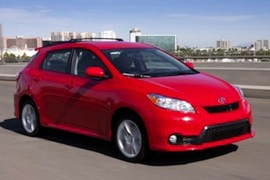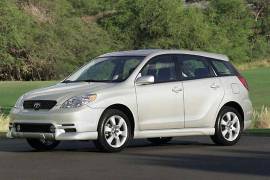TOYOTA Matrix Models/Series Timeline, Specifications & Photos
First production year: 2003
Engines: Gasoline
Body style: Hatchback
In late 2007, Toyota unveiled the second generation of the Matrix, and the automaker started the sales in early 2008 as a 2009 model year.
The Japanese automaker tried to provide customers with a compact hatchback vehicle that could be as spacious as a minivan but shorter than a station wagon. It was like a crossover but without the ground clearance. But customers didn’t care too much about labels but about the options, specs, and prices. They didn’t have any problems or questions regarding the vehicle’s reliability since Toyota was running the high tides on that factor. Furthermore, the automaker worked hard to develop a safe vehicle, and that was confirmed by the tests made by the NHTSA and the IIHS in the U.S. Both entities confirmed that the Matrix could pass all the crash tests with flying colors. While it didn’t get a five-star rating at the NHTSA for side impacts and rollover, it got four for that and five for the other three tests involved (driver’s front, driver’s side, and passenger’s front). In addition, the automaker offered the Matrix in a few trim levels and included an all-wheel drive version. Its sibling, the Pontiac Vibe, was axed from the assembly lines in 2009 while it was produced as a 2010 model year after GM decided to ditch the entire Pontiac brand. Those were the years of the world financial crisis when the automakers took a big hit.
At the front, the compact hatchback showed a sporty appearance thanks to its swept-back headlights that flanked a narrow upper grille. On the lower bumper, Toyota installed an additional center air intake flanked by a pair of scoops for the available fog lamps, depending on the trim level. For the XRS, the sportiest version, the automaker added a specific badge integrated into the upper mesh grille.
From its profile, the short hood was followed by a raked windshield. The Matrix’s waistline slightly ascended from the headlights to the C-pillars, and Toyota made the car with blackened B-posts to create an image of a three-door hatchback. Furthermore, depending on the grade, the sloped-down roofline was ended by a spoiler mounted atop the tailgate. Standard wheels for most versions included 16-inch alloy wheels with an option for a 17-inch set, while the XRS was fitted as standard with 18-inch alloys. From behind, the corner-mounted taillights were positioned high to be better protected against scratches and small bumps. The automaker provided the Matrix with a single or twin exhaust at the back, depending on the grade.
Inside, Toyota installed a driver-oriented dashboard, where the center console sported a light-gray color, while the one fronting the passenger was black. Behind the steering wheel, the instrument cluster boasted a binocular styling, with individual surroundings for the center-mounted speedometer flanked on the left by the tachometer and on the right by an oval-shaped cluster that featured the fuel and temperature gauges, plus the LCD for the odometer. In the back, the 60/40 split-folding bench seat could accommodate up to three passengers. Despite having a transmission tunnel, there was adequate legroom for the one seated in the middle.
Under the hood, the automaker installed a choice of two engines that provided 132 hp (134 PS) and 158 hp (160 PS), respectively. There were three gearboxes to choose from, depending on the trim: a five-speed manual and a four- or a five-speed automatic. The latter was installed in the XR and the XRS versions. Surprisingly, Toyota offered the car with different rear suspensions, including a double-wishbone for the XRS.
Toyota introduced the Matrix in 2003 on the same platform as the famous Corolla lineup, but it designed it to be appealing to younger customers.
Younger generations didn’t want to drive their parents’ cars anymore and wanted something that could express their personality. Toyota noticed that and created the Matrix. A vehicle that relied on the trustworthy platform of the Corolla’s ninth generation (the E 130) but styled like a larger hatchback. In addition, the car was available in a few grades, including sportier and all-wheel drive versions. Furthermore, it could be bought with less than 3,000 hours on minimum wage, meaning students could afford it on a five-year lease program. Moreover, it promised a fun-to-drive experience despite its small-sized engine. However, its look was an essential sales factor that helped the automaker deliver almost 100,000 units until the second generation appeared on the market in late 2007 for the 2008 model year.
With a front fascia that looked nothing like a Corolla, the Matrix featured swept-back headlights flanked by a trapezoidal grille where the carmaker’s badge took center stage. The bumper differed from one grade to another, and the top-spec version, named the XRS, had a road-hugging attitude inspired by rally cars. It had a center air intake flanked by round fog lamps and slatted side scoops.
From its profile, the Matrix showed a short hood with a steep windshield that paved the way to a tall greenhouse. From the A-pillars to the back, the roofline followed a slightly descending line, emphasized by the window line featuring dark B- and C-pillars. Furthermore, the D-pillars were also black, leaving the impression of a wrap-around window area. Surprisingly, even the base version featured a roof spoiler mounted atop the tailgate. Still, Toyota reduced the production costs of that version by installing black door mirror caps and handles. Out back, the corner-mounted taillights featured clear lower lenses, which made them look like aftermarket parts. It was the era of car-related movies with the tuner communities, such as the first two episodes of “The Fast and the Furious” saga.
Inside, the high-mounted seats led to enough room for up to five occupants. Furthermore, even though the center tunnel crossed the car from front to back, there was enough legroom for the middle-seated passenger in the back. Up front, the driver fronted an instrument panel with four individual clusters that housed the speedometer in the middle, the tachometer on the left, and the fuel level and temperature gauges on the right. The center stack housed the HVAC control unit, the stereo, and the gear stick. Even the base model of the Matrix featured AC, and that helped Toyota with the sales.
Under the hood, the automaker installed a few versions of its renowned 1.8-liter inline-four gasoline engine. The base version provided just 130 hp (132 PS), while the top-spec version borrowed its heart from the Toyota Celica GTS and produced a healthy 180 hp (182 PS) from the same 1.8-liter dual overhead camshaft powerplant. Toyota offered the Matrix with either a five-speed manual, a four-speed automatic, or a five-speed automatic. The hottest model, the XRS, came standard with a six-speed manual.

